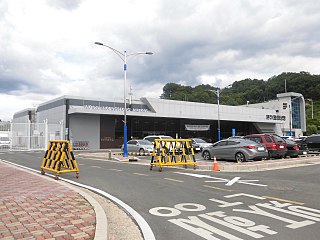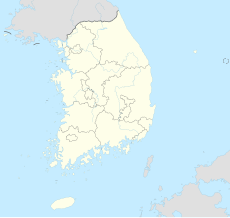
Incheon International Airport is the main international airport serving Seoul, the capital of South Korea. It is also one of the largest and busiest airports in the world.

Gimpo International Airport, formerly rendered in English as Kimpo International Airport, is located in the far western end of Seoul, some 15 km (9 mi) west of the Central District of Seoul. Gimpo was the main international airport for Seoul and South Korea before being replaced by Incheon International Airport in 2001. It now functions as Seoul's secondary airport. In 2015, over 23 million passengers used the airport, making it the third-largest airport in Korea, as it has been surpassed by Jeju International Airport.

Jeju International Airport is the second-largest airport in South Korea, just behind Incheon Airport in Incheon. It is located in the city of Jeju. The airport opened in 1968.

Cheongju International Airport is an international airport in Cheongwon-gu, Cheongju, South Korea. It also serves the cities of Daejeon and Sejong. In 2018, 2,453,649 passengers used the airport. It also houses the 17th fighter wing of the ROKAF. There is a railway station next to the airport, called Cheongju Airport station, which is on the Chungbuk Line.

Pohang Gyeongju Airport is an airport in Pohang, North Gyeongsang Province, South Korea. In 2011, 255,227 passengers used the airport.

Wonju Airport is an airport in Hoengseong County, Gangwon, South Korea. During the Korean War it was designated K-46 by the United States Air Force. In 2011, 70,943 passengers used the airport, which is mainly for military use.

Sacheon Airport is an airport in Sacheon, South Gyeongsang Province, South Korea. It also serves the city of Jinju. The airport passenger service began in 1977 after years of delays. The airport has a small single storey terminal building for domestic flights. In 2011, 143,483 passengers utilized the airport. Because Sacehon Airport is sharing with military, taking photograph or video of apron, runway and military facility is strictly prohibited.

Yeosu Airport is an airport in Yeosu, South Jeolla Province, South Korea. In 2018, 590,112 passengers used the airport.

Muan International Airport is an international airport in Muan County, South Jeolla Province, South Korea. Construction of the airport began in 1997 and the airport opened on November 9, 2007. The airport serves the province of South Jeolla, especially the cities of Gwangju, Mokpo and Naju. It replaced the nearby Mokpo Airport and is expected to replace the nearby Gwangju Airport in the near future as well. In 2018, 543,247 passengers used the airport. The airport is managed by the Korea Airports Corporation.
Jin Air Co., Ltd. is a South Korean low-cost airline. As of April 2018 it operates flights to six domestic cities and 26 international destinations. It launched its first long haul route, between Incheon and Honolulu, in December 2015. It has operated cargo services since November 2013. Jin Air is the first widebody LCC operator in Korea.

Eastar Jet is a South Korean low-cost airline with its headquarters in Banghwa-dong, Gangseo-gu, Seoul. On January 7, 2009, Eastar Jet made its maiden flight from Gimpo International Airport to Jeju International Airport. Now, the airline operates a scheduled passenger network to 14 destinations in eight countries. Its main base is Gimpo International Airport, with a hub at Jeju International Airport.
Air Busan Co., Ltd., operating as Air Busan is a low-cost airline based in Busanjin-gu, Busan, South Korea. It is a subsidiary of Asiana Airlines. The airline began its operation in 2007 as Busan International Airlines Company ; it launched service in October 2008.

T'way Air Co., Ltd., formerly Hansung Airlines, is a South Korean low-cost airline based in Seongsu-dong, Seongdong-gu, Seoul, South Korea. As of 2019, it was the third largest Korean low-cost carrier in the international market, having carried 2.9 million domestic passengers and 4.2 million international passengers in 2018. Its international traffic had quadrupled in the three years leading up to 2019.
Air Incheon (Korean: 에어인천) is a South Korean cargo airline with its base at Incheon International Airport near Seoul. It serves five scheduled cargo destinations from its base in Seoul.
Air Seoul (Korean: 에어서울) is a South Korean low-cost carrier and a subsidiary of Asiana Airlines. The airline is based at Incheon International Airport just outside of Seoul, from which it operates flights to international destinations. It launched operations on 11 July 2016.
Fly Gangwon was a short-lived South Korean low-cost airline which was founded in 2016 and made its maiden flight on 22 November 2019 from Yangyang to Jeju. The company slogan was Fly To Your Dream. On 19 May 2023 the airline ceased all flight operations and filed for bankruptcy protection.
Air Premia, Inc. is a South Korean airline based in Seoul. It describes itself as a "hybrid airline", providing a higher level of service than low-cost airlines while having lower operating costs than larger, full-service airlines. The airline was founded in 2017 by the former president of Jeju Air, Kim Jong-chul.











